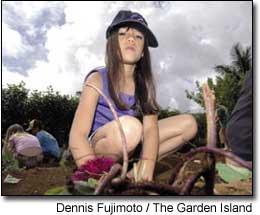KILAUEA — The true value of the Kalihiwai field trips shone brighter than the morning sun Friday.
“It’s so nice to see students step up to become leaders,” kumu Mauli Cook, one of the leaders for the Malama Kalihiwai program said while surveying the activity taking place throughout the campus of Kilauea School.
“Students in the older classes are becoming leaders as they try to organize students in the younger grades,” Cook said, between classes at the Pole Fishing station.
Cook was no stranger to the capabilities of the school students as she received kokua from three boys: Marlon Cudiamat, Colby Baliaris, and Kalen Galtes. Following her presentation, enhanced by those from the students, the trio would man three “fishing holes” where visiting students could snag a fish.
“This is all the idea of Naomi Yokotake,” Cook said. “The Malama Kalihiwai Day was designed to translate into real learning.”
For months, the Kilauea School students have been making field trips to Kalihiwai where they were involved in various aspects of taking care of the environment. These activities spanned a variety of topics and were liberal in the amount of hands-on participation in areas such as planting a sweet potato field, tending for taro lo’i, learning how to throw fishnets, and more.
Results of these learning excursions were brought to light Friday as students, unarmed with notes, worked with their fellow students in the younger grades to teach and explain what was taking place in any of the 22 various stations set up throughout the Kilauea School campus.
“Learning is not just about scores,” Cook said. “It’s about students wanting to learn, and learning how to become leaders.”
For school leaders, this was a true assessment of the program. There were no exams or quizzes, just the opportunity for students to demonstrate what they learned during the field trips.
In addition to the hands-on activities, Yokotake noted that there were other educational stations set up such as the Wai station that involved students playing a game that centered around concepts of the watershed.
“It’s nice to see how students respond when given the responsibility,” Kilauea School principal Fred Rose said. “One teacher noted that a student who would normally be a problem in other situations was working with other students in trying to get them organized for one of the events.”
Rose said that while talking to one of the community old-timers, he was told that there was a garden in one area. On Friday, a garden was taking place as various classes were involved in different phases of the creation of a sweet potato patch.
Other arenas also included the traditional Hawaiian games of Haka Moa, Ulu Maika, Kukini, and O’O ihe.
More practical workshops and stations revolved around the creation of lei, information on coconut, estuary, and the cleaning and cooking of akule where the students were allowed to sample their efforts after it was cooked over a grill wrapped in ti leaf.
Titus Kinimaka, a surfer and waterman, joined some of the other community volunteers in talking to students about water safety while Chauncy Pa worked with students in teaching them how to throw a fishnet.
“These volunteers are great,” Cook pointed out. “But, the true value of what they have to teach is in the students and how they are able to teach other students what they’ve learned from these people.”


